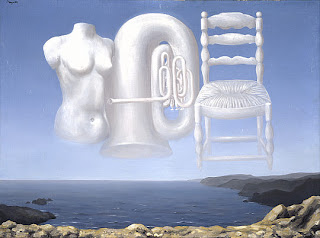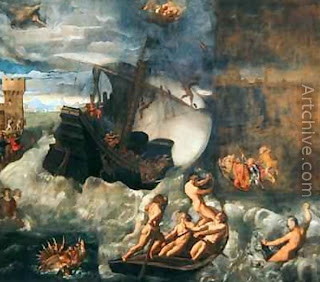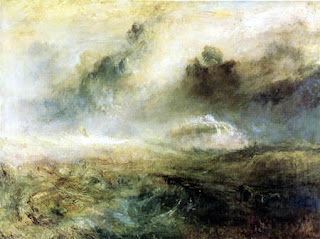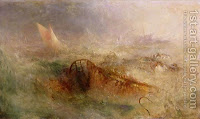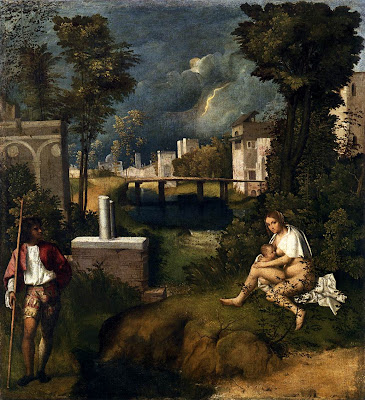
Giorgione's Tempest, which has come to be known as the West's first landscape, immediately sets out to depict cumulonimbus cloud formations, making the highest vertical grid active and rendering the grids below passive, the threatening representation of water balanced by brooks and the maternal images of nursing and the stork. It has come to be a depiction of its interpreters as well as its own subject matter: Judeo-Christians suggest this is a rest on the flight to Egypt, the flight from Paradise or the broken pillar of the Philistines, Classicists suggest it's the abandoned Oenone amid the storm of the Trojan War, fatalists suggest allegorical figures awaiting the storm's destiny. X-rays have shown the figure on the left was originally a female bather, lessening the likelihood of a specific symbolist intention.
The broken pillar has elsewhere been a symbol for death, and traditional Eastern symbolism of the storm has focused on the its dual nature of death and rebirth such as the Japanese god Susano-o and Indra's maruts. The death of 46 people in Maharashtra this month in the early days of the monsoon is culturally weighed against the need for the phenomenon. If Giorgione was aware of harvest rituals it would have added to his incentive for ambiguity, as his Three Philosophers clearly indicates his integration of Eastern ideas.
Those who dispute a symbolic strategy are more likely to suggest that the characters are gypsies on the periphery of the city, literal personifications of the convergence of East and West. This motif has been developed in modernity by Manet and Picasso, examples of both which can be found the DC's NGA and suggest a newer symbolism that can be approached only by visual observation. Courbet never used classical or religious symbolism in his landscapes save for his use of water and female figures in his "the source" series; Pisarro proceeded similarly. The storm was a common subject of Mannerism as with El Greco and where classical or Christain iconography fell out of favor, a Baroque fatalism remained as with Donne's The Storm, inspired by his sailing as a young man against Spain in the late 16th Century where his proud, sheltered British self-image is imbued with reverence for Nature, or Shakespeare's use of the tempest to represent the divining art of theatrical illusion. A few years later the Christian allusion would return with Rembrandt's only seascape, The Storm on the Sea of Galilee,

an episode that Delacroix would paint repeatedly, which used Christ's sleep to illustrate calmness in the face of chaos and being at one with nature.
The storm taken up by Edvard Munch, the figures are again in the foreground, but with none of the contentedness of Giorgione's figures or Christ on a boat.
The storm becomes an allegory of representation in Magritte's Threatening Weather:
Or Leonora Carrington's clouds:

When George Grosz moved to America he began to paint landscapes with none of the social commentary (and people lost interest in him as a result). The American depiction of the storm has mostly followed the same vein, as with John Marin's storms-for-storms-sake (Storm Over Taos).

Kay Sage eliminates nature, keeping only the wind:

All these potential uses for the storm in painting were contained in Giorgione's canvases.

